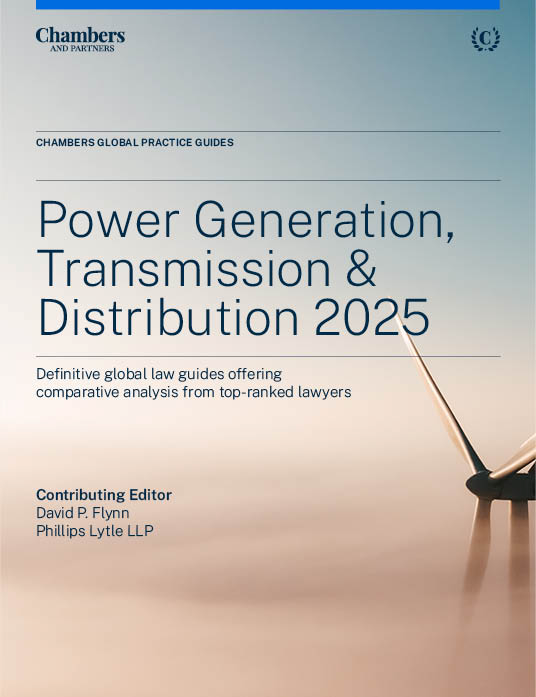
Power Generation, Transmission & Distribution 2025
The Power Generation, Transmission and Distribution 2025 guide covers key jurisdictions across Europe, the United States and the Asia-Pacific region. The guide provides the latest legal information on the structure and ownership of the power industry; supply and pricing; and regulations regarding electricity generation, transmission and distribution.
Last Updated: July 17, 2025
Compare law and practice by selecting locations and topic(s)
Select Locations

Select Topic(s)

Please select at least one location and one topic to use the compare functionality.
Transformation in the Power Industry
We are pleased to present the Chambers Global Practice Guide for Power Generation, Transmission and Distribution. Much is occurring in this dynamic space. A fundamental transformation of the electric energy and power industry is under way, and a number of things are driving change, growth and innovation. Technological advancement, engaged and educated customers, evolving regulatory requirements, economic impacts, and the constant reminder of significant climate change are all driving growth and development in this space.
As the market continues to evolve at a fast pace, the legal and regulatory systems are often driving some of these changes; at the same time, these same systems are, in certain instances, forced to play the difficult role of catch-up. That is certainly the case with the power industry. This Guide seeks to inform readers as to what various jurisdictions are doing to drive industry changes, respond to significant market evolution, and foster, encourage and manage the development of their energy resources.
While change in the energy sector has always occurred, it has been at a much different pace and scale in recent years. While the primary driver in the evolution of this sector was once the unbundling/deregulation of the utility industry, that has clearly changed. Though the unbundling of utilities continues, the legal and regulatory framework in many jurisdictions is also evolving to encourage – if not mandate – new non-carbon sources of electric energy as well as new entrants into the energy generation and transmission market. Every indication is that this will continue, and most likely accelerate, in many jurisdictions.
Legal and Regulatory Frameworks
Today, many of the changes in the legal and regulatory frameworks that pertain to the energy sector are impacted – if not driven by – unparalleled technological change. While wind and solar generation have been around for many years, the scope and deployment of these energy resources is approaching levels that require changes to the existing legal framework in place in many jurisdictions. In addition, emerging technologies, which are critical to addressing and supporting efforts to decarbonise, are becoming more impactful. Things such as large-scale energy storage, hydrogen and even a potential resurgence in nuclear energy are all creating pressures on existing legal and regulatory frameworks. These changes are causing jurisdictions to adjust in order to respond to these new and/or emerging technologies.
All of these changes – whether they relate directly to decarbonisation or to the further penetration of alternative energy sources – impact the energy consumer. At the individual consumer level, this results in potentially significant impacts to power quality, increases in energy costs to facilitate and underwrite the increased electrification of our economies, as well as potentially more costly sources of energy generation. The impacts to large energy consumers, such as large manufacturing operations and other energy-intensive businesses, can be game-changers. For large industrial users of electricity, energy is tantamount to a raw material. An industry’s ability to manage potentially significant increases in cost over a relatively short period of time can have material consequences. Therefore, it is important for the legal and regulatory frameworks in the various jurisdictions that are aggressively moving forwards with decarbonisation and/or electrification to manage the process, such that the costs do not escalate out of control or lead to unintended economic consequences.
Decarbonisation
Ongoing efforts to decarbonise the energy and power sector, together with a push to use renewable energy resources to replace carbon-based generation, is creating both opportunity and tension. The opportunity is an almost limitless market to provide new and/or emerging technologies that do not rely on carbon or a carbon-based fuel to provide electric energy. There is also a very significant effort focused on further electrification of our economies and life – for example, transitioning from natural gas or coal as a source of heat, with an ever-increasing reliance on electric energy. This is creating incredible pressure on generation, transmission and distribution capabilities around the world.
Certain estimates of growth in the energy sector put this into some context. Growth in renewable energy (primarily solar and wind) may result in renewable energy generation representing almost 40% of all global energy generation by 2040. In certain jurisdictions, the penetration of renewables and other non-carbon-based energy sources could reach double that number.
With the tangible impacts of climate change seemingly presenting themselves on an almost daily basis, more and more countries are recognising the need to decarbonise their economies. What could have been a more gradual transition is now taking on the feel of a crisis. This is forcing very significant (and costly) changes to occur in a very short period of time. It is also forcing the existing legal and regulatory frameworks and systems in many countries to evolve at a pace that is uncharacteristic for this sector. Consequently, it is imperative for those entities that are either impacted or involved in the decarbonisation effort to use tools such as this Guide to better understand and facilitate the implementation of the decarbonisation efforts.
